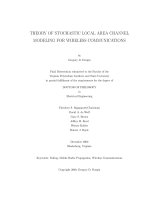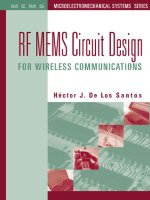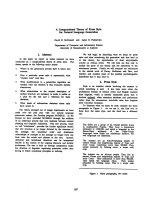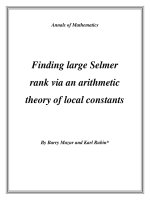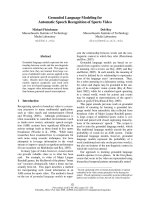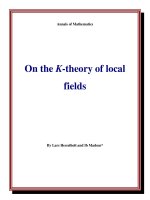Theory of stochastic local area channel modeling for wireless communications
Bạn đang xem bản rút gọn của tài liệu. Xem và tải ngay bản đầy đủ của tài liệu tại đây (1.36 MB, 207 trang )
THEORY OF STOCHASTIC LOCAL AREA CHANNEL
MODELING FOR WIRELESS COMMUNICATIONS
by
Gregory D. Durgin
Final Dissertation submitted to the Faculty of the
Virginia Polytechnic Institute and State University
in partial fulfillment of the requirements for the degree of
DOCTOR OF PHILOSOPY
in
Electrical Engineering
Theodore S. Rappaport(Chairman)
David A. de Wolf
Gary S. Brown
Jeffrey H. Reed
Werner Kohler
Robert J. Boyle
December 2000
Blacksburg, Virginia
Keywords: Fading, Mobile Radio Propagation, Wireless Communications
Copyright 2000, Gregory D. Durgin
THEORY OF STOCHASTIC LOCAL AREA CHANNEL
MODELING FOR WIRELESS COMMUNICATIONS
Gregory D. Durgin
(ABSTRACT)
This report was written to satisfy the final dissertation requirements toward a doctoral
degree in electrical engineering. The dissertation outlines work accomplished in the pursuit
of this degree. This report is also designed to be a general introduction to the concepts and
techniques of small-scale radio channel modeling. At the present time, there does not exist
a comprehensive introduction and overview of basic concepts in this field. Furthermore, as
the wireless industry continues to mature and develop technology, the need is now greater
than ever for more sophisticated channel modeling research.
Each chapter of this preliminary report is, in itself, a stand-alone topic in channel
modeling theory. Culled from original reports and journal papers, each chapter makes a
unique contribution to the field of channel modeling. Original contributions in this report
include
joint characterization of time-varying, space-varying, and frequency-varying channels
under the rubric of duality
rules and definitions for constructing channel models that solve Maxwell’s equations
overview of probability density functions that describe random small-scale fading
techniques for modeling a small-scale radio channel using an angle spectrum
overview of techniques for describing fading statistics in wireless channels
results from a wideband spatio-temporal measurement campaign
Together, the chapters provide a cohesive overview of basic principles. The discussion of
the wideband spatio-temporal measurement campaign at 1920 MHz makes an excellent case
study in applied channel modeling and ties together much of the theory developed in this
dissertation.
ii
Contents
(ABSTRACT) ii
1 Introduction 2
1.1 TheNeedforImprovementinChannelModelingTheory........... 3
1.1.1 HigherandHigherDataRates ..................... 3
1.1.2 UbiquityofWirelessDevices ...................... 4
1.1.3 SmartAntennas ............................. 4
1.1.4 Faster,Smaller,CheaperHardware................... 4
1.1.5 FrequencyCongestion .......................... 5
1.1.6 Multiple-Input, Multiple-Output Systems . . ............. 5
1.2 KeyTopicsinSmall-ScaleChannelModeling ................. 6
1.2.1 Spatial,Temporal,andFrequencyCoherence ............. 6
1.2.2 RigorousApplicationofPhysicstoChannelModels ......... 6
1.2.3 Physically-BasedSmall-ScaleFadingDistributions .......... 7
1.2.4 CharacterizationandAnalysisofAngleSpectra............ 7
1.2.5 ChannelStatisticsofRayleighFading ................. 7
1.2.6 Spatio-TemporalPeer-to-PeerMeasurements ............. 8
1.3 HowtoReadThisDissertation ......................... 9
2 Foundations of Stochastic Channel Modeling 10
2.1 BasebandRepresentation ............................ 11
2.1.1 SignalModulation ............................ 11
2.1.2 TheBasebandChannel ......................... 15
2.1.3 Time-Invariantvs.Time-VaryingChannels .............. 15
2.1.4 Detection ................................. 18
2.2 ChannelCoherence ............................... 20
2.2.1 Coherencevs.Selectivity ........................ 20
iii
2.2.2 TemporalCoherence........................... 20
2.2.3 FrequencyCoherence........................... 22
2.2.4 SpatialCoherence ............................ 23
2.3 UsingtheCompleteBasebandChannel .................... 26
2.3.1 SpectralDomainRepresentations.................... 26
2.3.2 GeneralSignalTransmission ...................... 28
2.3.3 StaticChannelTransmission ...................... 28
2.3.4 Mobile Receiver Transmission . . .................... 29
2.4 StochasticChannelCharacterization ...................... 30
2.4.1 AutocorrelationRelationships ..................... 30
2.4.2 PowerSpectrum ............................. 32
2.4.3 RMSPowerSpectrumWidth...................... 36
2.4.4 ChannelDualityPrinciple ....................... 41
2.5 ChapterSummary ................................ 43
2.A FunctionsofThree-DimensionalSpace..................... 44
2.A.1 VectorNotationforFourierTransforms ................ 44
2.A.2 ScalarCollapseofPositionVectors .................. 45
2.A.3 ScalarCollapseofWavevectors ..................... 46
3 The Physics of Small-Scale Fading 49
3.1 PlaneWaveRepresentation ........................... 50
3.1.1 Electromagnetic Fields and Received Signals ............. 50
3.1.2 The Maxwellian Basis . . . . . . .................... 51
3.1.3 HomogeneousPlaneWaves ....................... 53
3.1.4 InhomogeneousPlaneWaves ...................... 53
3.1.5 PhysicsofHomogeneousvs.InhomogeneousPlaneWaves ...... 55
3.2 TheLocalArea ................................. 60
3.2.1 DefinitionofaLocalArea........................ 60
3.2.2 ScattererProximity ........................... 60
3.2.3 AWidebandPlaneWave ........................ 62
3.2.4 TheBandwidth-DistanceThreshold .................. 64
3.3 WaveGroupings ................................. 67
3.3.1 SpecularWaveComponent ....................... 67
3.3.2 Non-specularWaveComponent..................... 67
3.3.3 DiffuseWaveComponent ........................ 68
3.3.4 ReducedWaveGrouping ........................ 68
iv
3.4 TheStochasticLocalAreaChannel(SLAC)Model ............. 70
3.4.1 StochasticModel............................. 70
3.4.2 RandomPhaseModels.......................... 71
3.4.3 FourierTransforms............................ 73
3.4.4 AutocorrelationFunctions........................ 74
3.4.5 HeterogeneousScattering ........................ 75
3.4.6 PowerSpectrum ............................. 76
3.5 ChapterSummary ................................ 80
3.A WavevectorCriterionforFreeSpacePlaneWaves .............. 81
4 First-Order Statistics of Small-Scale Channels 82
4.1 Mean Received Power .............................. 83
4.1.1 Stationarity................................ 83
4.1.2 MeanU-SLACPower .......................... 85
4.1.3 FrequencyandSpatialAveraging.................... 85
4.1.4 Ergodicity................................. 86
4.2 Envelope Probability Density Functions .................... 89
4.2.1 NotesandConcepts ........................... 89
4.2.2 CharacteristicFunctions......................... 89
4.2.3 SpecularCharacteristicFunction .................... 90
4.2.4 Diffuse,Non-specularCharacteristicFunction............. 91
4.2.5 TheI-SLACPDFGenerator ...................... 92
4.3 Closed-FormPDFSolutions .......................... 93
4.3.1 TheOne-WavePDF ........................... 93
4.3.2 TheTwo-WavePDF........................... 93
4.3.3 TheThree-WavePDF .......................... 96
4.3.4 TheRayleighPDF............................ 96
4.3.5 TheRicianPDF ............................. 98
4.4 Two-WavewithIncoherentPower(TIP)PDF ................ 100
4.4.1 ApproximateRepresentation ...................... 100
4.4.2 GraphicalAnalysis............................ 102
4.4.3 RayleighandRicianApproximations.................. 102
4.4.4 FinalCommentsonReducedWaveGroupings ............ 108
4.4.5 TIPPDFApplications.......................... 110
4.4.6 ClosingRemarksonTIPFading .................... 110
4.5 ChapterSummary ................................ 112
v
4.A DerivationofEnvelopeCharacteristicFunctions................ 113
4.B DerivationforTIPFadingPDF’s........................ 115
4.B.1 ApproximateRepresentation ...................... 115
4.B.2 PropertyasaPDF............................ 116
4.B.3 ProperLimitingBehavior ........................ 117
4.B.4 PreservationoftheSecondMoment .................. 117
5 The Angle Spectrum 118
5.1 AngleSpectrumConcepts ............................ 119
5.1.1 DefinitionoftheAngleSpectrum.................... 119
5.1.2 MappingAnglestoWavenumbers.................... 120
5.1.3 From-the-Horizon Propagation . .................... 121
5.1.4 SummaryofAngleSpectrumConcepts................. 124
5.2 FadingRateVariance .............................. 127
5.2.1 DefinitionofaRateVariance ...................... 127
5.2.2 Fundamental Spectral Spread Theorem . . . ............. 129
5.3 MultipathShapeFactors ............................ 130
5.3.1 DefinitionofShapeFactors ....................... 130
5.3.2 BasicWavenumberSpreadRelationship ................ 131
5.3.3 Comparison to Omnidirectional Propagation ............. 132
5.4 IllustrativeExamples .............................. 134
5.4.1 Two-WaveChannelModel........................ 134
5.4.2 SectorChannelModel .......................... 134
5.4.3 DoubleSectorChannelModel...................... 136
5.4.4 RicianChannelModel.......................... 138
5.5 ChapterSummary ................................ 140
5.A DerivationofShapeFactors .......................... 142
6 Rayleigh Fading Channel Statistics 144
6.1 TheLevel-CrossingProblem .......................... 145
6.1.1 Level-CrossingRate ........................... 145
6.1.2 AverageFadeDuration ......................... 146
6.1.3 LevelCrossinginFrequency....................... 146
6.1.4 LevelCrossinginSpace ......................... 147
6.2 EnvelopeUnitAutocovariance ......................... 148
6.2.1 TemporalUnitAutocovariance ..................... 148
vi
6.2.2 FrequencyUnitAutocovariance..................... 149
6.2.3 SpatialUnitAutocovariance....................... 150
6.2.4 JointUnitAutocovariance........................ 151
6.3 RevisitingClassicalSpatialChannelModels ................. 153
6.3.1 ClassicalSpatialChannelModels.................... 153
6.3.2 ChannelModelSolutions ........................ 154
6.3.3 AdditionalComments .......................... 155
6.4 ChapterSummary ................................ 158
6.A ApproximateSpatialAutocovarianceFunction ................ 159
7 Spatio-Temporal Measurements 161
7.1 PreviousMeasurementCampaigns ....................... 162
7.1.1 ContributionofthisWork........................ 162
7.1.2 Comparison to Other Measurement Campaigns in the Literature . . 162
7.2 OverviewofMeasurementCampaign ..................... 164
7.2.1 MeasuredLocations ........................... 164
7.2.2 Channel Sounding Hardware . . .................... 164
7.2.3 AutomatedAntennaPositioning .................... 166
7.2.4 AntennaSpecifications.......................... 169
7.2.5 SourcesofErrorintheExperiment................... 169
7.3 Results ...................................... 173
7.3.1 DelayDispersionResults ........................ 173
7.3.2 AngleDispersionResults ........................ 175
7.3.3 JointAngle-DelayStatistics ...................... 178
7.4 Conclusions.................................... 180
7.A DescriptionofMeasuredParameters ...................... 181
7.A.1 NoncoherentChannelMeasurements.................. 181
7.A.2 PowerSpectra .............................. 182
7.A.3 TimeDelayParameters ......................... 182
7.A.4 Angle-of-ArrivalParameters....................... 184
8 Conclusions 185
8.1 FutureAreasofResearch ............................ 186
8.1.1 TheoreticalFramework ......................... 186
8.1.2 SpecificAnalyticalProblems ...................... 186
8.1.3 ApplicationstoWirelessTechnology .................. 187
vii
8.1.4 MeasurementTheory........................... 187
8.1.5 ComputerSimulation .......................... 187
9 Vitae 189
Bibliography 190
viii
List of Tables
2.1 Received signal functions used in complex baseband analysis. . . ...... 19
2.2 Fouriertransformdefinitionsforeachchanneldependency. ......... 27
2.3 Channel duality relationships between time, frequency, and space. . . . . . 42
3.1 Maximum size of a local area according to the bandwidth-distance threshold
forexamplewirelessapplications. ....................... 66
3.2 ReducedWaveGroupingAlgorithm ...................... 69
4.1 SummaryofenvelopePDF’sindifferentfadingenvironments. ....... 94
4.2 Exact coefficients for the first five orders of the approximate Two-Wave with
IncoherentPower(TIP)fadingPDF. ..................... 100
4.3 The TIP PDF contains the Rayleigh, Rician, One-Wave, and Two-Wave
PDF’sasspecialcases. ............................. 102
4.4 Three examples of Two-Wave with Incoherent Power (TIP) fading that may
simplifytoRayleighorRicianPDF’s. ..................... 107
7.1 Summary of dispersion statistics calculated from track measurements. . . . 174
7.2 Summary of spatial multipath parameters calculated from spatially-averaged
azimuthalsweepsofahornantenna. ...................... 176
ix
List of Figures
2.1 Themanydifferentbandwidthsdefinedforabasebandsignal. ....... 12
2.2 Baseband-Passband transformations in the time domain (inner cycle) and
thefrequencydomain(outercycle). ...................... 13
2.3 Block diagram of baseband and passband channel models for SISOtransmis-
sion. ....................................... 16
2.4 Spectraldiagramofbasebandandpassbandsignalsandchannel. ...... 17
2.5 Exampleofatime-varyingchannel. ...................... 21
2.6 Exampleofafrequency-varyingchannel. ................... 22
2.7 Exampleofaspace-varyingchannel(one-dimensionalcut). ......... 23
2.8 Exampleofsmall-scaleandlarge-scalefading. ................ 24
2.9 Autocorrelation and power spectrum relationships for time and frequency. 33
2.10 Autocorrelation and power spectrum relationships for space and frequency. 35
2.11 Autocorrelation and power spectrum relationships for space, time, and fre-
quency. ...................................... 37
2.12 Relationship between (x, y, z)and(r, θ, ϕ)coordinates. ........... 45
3.1 An antenna maps the complex electric field vector,
˜
E(r), to a scalar baseband
channel voltage,
˜
h(r). .............................. 50
3.2 Homogeneousandinhomogeneousplanewaves. ............... 54
3.3 Rules-of-thumb for homogeneous and inhomogeneous plane wave propaga-
tion. ....................................... 57
3.4 An example linear circuit contains capacitors, inductors, resistors and an AC
source. ...................................... 58
3.5 A linear circuit solution may be broken into a steady-state and transient
solution. ..................................... 59
3.6 Thesizeofalocalareadecreasesclosertosignificantscatterers. ...... 61
3.7 Illustration of the basic quantities of time-harmonic wave propagation through
ascatteringenvironment. ............................ 63
x
3.8 Examples of different delay spectra using the standard power spectrum,
S
˜
h
(τ), and the integrated power spectrum, F
˜
h
(τ). .............. 78
4.1 EvolutionofaTwo-WavePDFandCDFwithvarying∆. .......... 95
4.2 Several CDF’s and PDF’s for Three-Wave local area propagation. ...... 97
4.3 Evolution of a Rician PDF and CDF as the dominant multipath component
increases. (σ =
P
dif
/2)............................. 99
4.4 TIPPDFandCDFforK =0dB.(σ =
P
dif
/2)............... 103
4.5 TIPPDFandCDFforK =3dB.(σ =
P
dif
/2)............... 104
4.6 TIPPDFandCDFforK =6dB.(σ =
P
dif
/2)............... 105
4.7 TIPPDFandCDFforK =10dB.(σ =
P
dif
/2) .............. 106
4.8 A flowchart for determining the simplest way to graph an I-SLAC PDF. . . 109
5.1 A local area characterized by an angle spectrum, p(θ, ϕ), will produce differ-
ent wavenumber spectra, S
˜
h
(k), depending on the orientation in space. . . 121
5.2 Multipath power is mapped from the angle spectrum, p(θ), to the wavenum-
ber spectrum, S
˜
h
(k),asafunctionofitsangle-of-arrival. .......... 123
5.3 Autocorrelation and spectrum relationships for the space-varying channel. 125
5.4 Two examples of time-varying, Rayleigh-distributed stochastic processes. . 127
5.5 Two-wave propagation model. Graphs are for the special case of P
1
= P
2
. . 135
5.6 Multipath sector propagation model. . . .................... 137
5.7 Multipath double sector propagation model. . . . . . ............. 138
5.8 Rician propagation model. . . . . . . . . .................... 139
6.1 Threedifferentmultipath-inducedmobile-fadingscenarios........... 153
6.2 Comparison between Clarke theoretical and approximate envelope autoco-
variance functions for E
z
-case. ......................... 155
6.3 Comparison between Clarke theoretical and approximate envelope autoco-
variance functions for H
x
-case. ......................... 156
6.4 Comparison between Clarke theoretical and approximate envelope autoco-
variance functions for H
y
-case. ......................... 156
7.1 The transmitter-receiver configurations for the 6 local areas measured in-
doors. ....................................... 165
7.2 In a local area, power delay profiles are measured along two orthogonal linear
tracksusinganomnidirectionalantenna. ................... 167
7.3 A track measurement is made with an omnidirectional antenna in a campus
parkinglot. .................................... 168
xi
7.4 In a local area, power delay profiles are measured by spatially averaging
angularsweepswithadirectionalantenna. .................. 170
7.5 A rotational measurement is made with a directional horn antenna in the
lobbyofanofficebuilding. ........................... 171
7.6 A series of PDP snapshots along a track, measured with an omnidirectional
receiver antenna. . . .............................. 173
7.7 A local area angle-delay spectrum as measured from a set of rotational mea-
surements. .................................... 177
7.8 The trend between angle spread and delay spread for indoor and outdoor
receivers. ..................................... 179
xii
Acknowledgements
Any endeavor as large as a Ph.D. dissertation requires numerous contributions by people
other than the Ph.D. candidate. This dissertation is no exception, as there are a number
of organizations and people that must be acknowledged before a single technical detail can
be discussed.
First, there is a long list of generous sponsors and contributors. The research in this
dissertation was sponsored by a Bradley Fellowship in Electrical and Computer Engineer-
ing, the MPRG Industrial Affiliates Program, and ITT Defense & Electronics, Inc. The
peer-to-peer measurement campaign could not have been performed without the generous
assistance of MPRG students Vikas Kukshya, Jiun Siew, Erica Lau, Christopher Steger,
Paulo Cardieri, Jason Aaron, and Bruce Puckett.
I also owe an extreme debt of gratitude to everyone on my Ph.D. committee. Three
members in particular – Ted Rappaport, David de Wolf, and Gary Brown – contributed
numerous technical criticisms, ideas, and suggestions that found their way into the final
dissertation. I could not have asked for a more supportive (and knowledgeable) Ph.D.
committee.
An equal debt of gratitude is owed to the extremely talented students and staff of the
Mobile and Portable Radio Research Group of Virginia Tech. What wonderful people I
have worked with over the years! There are three students I would like to single out for
their help and devoted friendship throughout my dissertation: Neal Patwari, Hao Xu, and
Bruce Puckett.
Finally, my deepest gratitude and sincerest love is owed to these three people: my mother
Lisa, my father Dave, and my Lord and Savior Jesus Christ. A deep, loving relationship
with each has provided all inspiration and direction in life.
1
Chapter 1
Introduction
There are few things in nature more unwieldy than the power-limited, space-varying, time-
varying, frequency-varying wireless channel. Yet there is great reward for engineers who
can overcome these limitations and transmit data through such a harsh environment. The
explosive worldwide growth of personal communications services through the 1990’s is a
testament to the business opportunities that result from conquering the wireless channel.
However, given the emergence of newer wireless systems that require more and more band-
width, the task of conquering the wireless channel is becoming more difficult. This task
requires a thorough background in wireless channel modeling.
The main purpose of this dissertation is to present a foundational, physically-based
approach to modeling random behavior in wireless channels. Using sound principles in
stochastic process theory, electromagnetic wave propagation, and wireless communications,
this report develops a theoretical framework for characterizing stochastic local area radio
channels. The theory is applicable to any type of wireless data transmission, regardless of
bandwidth, carrier frequency, or environment of operation.
The final chapters of the dissertation deal with applied statistics and channel measure-
ments. Specifically, results from a wideband spatio-temporal measurement campaign are
presented that illuminate many of the concepts discussed in the previous chapters. The
wideband channel measurement campaign was performed in the 1850-1990 MHz frequency
bands on the campus of Virginia Tech. Using peer-to-peer configurations for transmitter
and receiver antennas (height of 1.5m above ground), this measurement campaign produced
results that characterize both frequency and spatial selectivity of locations. The results not
only validate research concepts developed in this report, but will assist industry in devel-
oping wireless modems for peer-to-peer networks.
2
CHAPTER 1. INTRODUCTION 3
1.1 The Need for Improvement in Channel Modeling Theory
The theory that engineers use to measure and model wireless communications has changed
very little over the last 30 years. The main reason for this stagnation of development may
be summed up as follows: the current theory still works for wireless systems that have been
deployed to date. Do not expect this statement to hold much longer. There are 6 current
trends in wireless communications which emphasize the need for improved and expanded
channel modeling theory.
1.1.1 Higher and Higher Data Rates
The capacity for data transmission of current wireless systems is still tiny when compared to
wired forms of communications. But wireless data rates continue to increase. To understand
the push for higher and higher data rates, it is useful to consider an analogy involving the
trends of memory size and processor speed in the personal computer market.
In the early 1980’s, a typical personal computer had about 64 kilobytes of RAM and op-
erated with a processor that clocked at speeds less than 1 MHz. At the time, the perception
of future computer hardware needs was best summarized by a famous industry magnate:
640 kilobytes [of RAM] ought to be enough for anybody.
-Bill Gates, 1981
In the year 2000, the typical personal computer has a processor that operates at a clock
frequency close to 1 GHz and requires as much as 100 MB of RAM – and this capability
continues to increase. In short, as soon as computer hardware is enhanced, new commercial
software applications are developed which exploit the new-found capacity for storing and
manipulating data.
The computer hardware illustration provides a valuable lesson for the wireless industry.
There is a basic rule that applies to all information technology: new hardware that increases
the capacity to store or manipulate data is quickly followed by new applications that exhaust
the resources. For wireless, this means that the current technology will continue to gravitate
towards higher transmitted data rates.
Of course, higher data rates translate into wireless systems that operate with wider
bandwidths. Future wireless systems will operate with bandwidths that greatly exceed con-
ventional channel models. New systems will require new channel models and measurements.
CHAPTER 1. INTRODUCTION 4
1.1.2 Ubiquity of Wireless Devices
Wireless personal communications has permeated nearly every environment on earth. It is
now possible to use a wireless handset in a city, in a car, in the home, in an office building,
on a boat – the list goes on. Future applications will involve wireless sensors and impersonal
communications between engines, machinery, and appliances.
The wireless channel is heavily dependent on the environment in which it operates. Since
future wireless applications will operate in nearly every imaginable environment, there will
be an incredibly diverse variety of channels that require characterization. In fact, many
of these new environments will defy characterization by the older paradigms of wireless
channel modeling.
1.1.3 Smart Antennas
Adaptive arrays and other types of smart antenna techniques are emerging technologies for
improving the wireless link and mitigating interference in a multiple access system [1, 2].
Many multi-user communication systems such as cellular radio networks have, until now,
operated well below their designed capacity. As the market for these systems has grown and
matured over the years, the network traffic has grown as well. Smart antenna technology is
seen as a cheap and effective solution for mitigating the problem of excess network traffic.
A directional antenna at a receiver or transmitter drastically changes the channel char-
acteristics. Channel models that once applied to omnidirectional antennas must be modified
and improved to account for the new spatio-temporal distortion of the channel by the di-
rectional antenna.
1.1.4 Faster, Smaller, Cheaper Hardware
Over the years, basic research in wireless communications has produced a plethora of modu-
lation, multiple access, and signal processing innovations that combat the distortions intro-
duced by a wireless channel. Only a small subset of these innovations are used in practice,
since many algorithms and techniques do not have a feasible realization in hardware.
Radio frequency and digital signal processing technology continues to develop, however.
The computational power of baseband chip sets is increasing. The radio frequency (RF)
integrated circuits are operating at higher power levels and at higher frequencies. Above all,
these transmitter and receiver components are becoming cheaper and cheaper to fabricate.
As a result, many algorithms and techniques which are not feasible to implement today,
will become feasible tomorrow.
CHAPTER 1. INTRODUCTION 5
The added capabilities of future radio receivers, therefore, will be able to combat the
detrimental effects of the multipath channel in new and innovative ways. With added
functionality, receivers of the future need more than just an ad-hoc approximation about
the radio channel. Future receiver designs will require models that mimic the detailed
dispersion, time-varying, and space-varying characteristics of a realistic wireless channel.
1.1.5 Frequency Congestion
Bandwidth is a finite resource. As wireless systems with wider and wider bandwidths
continue to deploy, frequency congestion becomes a problem. One solution is to move outside
of common frequency bands and into higher, uncrowded frequency in the upper microwave
and mm-wave bands. Propagation at these higher frequencies presents an entirely different
set of problems. Clearly, channel models developed around the 1 GHz microwave bands
are inadequate to characterize wireless systems where both the carrier frequency and signal
bandwidth are orders-of-magnitude greater.
1.1.6 Multiple-Input, Multiple-Output Systems
Perhaps one of the most interesting trends in wireless communications is the proposed
use of multiple-input, multiple-output (MIMO) systems. A MIMO system uses multiple
transmitter antennas and multiple receiver antennas to break a multipath channel into
several individual spatial channels. The resulting system then employs space-time coding to
increase the link capacity [3].
New MIMOsystems represent a huge philosophical change in how wireless communi-
cations systems are designed. This change reflects how we view multipath in a wireless
system:
The Old Perspective: The ultimate goal of wireless communications is to
combat the distortion caused by multipath in order to approach the theoretical
limit of capacity for a band-limited channel.
The New Perspective: Since multipath propagation actually represents mul-
tiple channels between a transmitter and receiver, the ultimate goal of wireless
communications is to use multipath to provide higher total capacity than the
theoretical limit for a conventional band-limited channel.
This philosophical reversal implies that many of the engineering design rules-of-thumb that
were based on pessimistic, worst-case scenario channel models have now become unrealisti-
cally optimistic. Design of such systems will require new space-frequency channel models.
CHAPTER 1. INTRODUCTION 6
1.2 Key Topics in Small-Scale Channel Modeling
Each chapter of this report addresses a key shortcoming in conventional channel modeling
theory. Each also builds on knowledge accumulated in the previous chapter, so that the
entire report may be read as a coherent, foundational development of wireless channel
modeling concepts. The various topics addressed by each of the chapters are discussed
below.
1.2.1 Spatial, Temporal, and Frequency Coherence
The linear time-invariant channel is well-understood by most engineers. Unfortunately,
the wireless channel is time-varying and space-varying as well as frequency selective.A
general approach to channel modeling must consider all three possible variations – frequency,
time, and three-dimensional space – in order to characterize the end-to-end performance of
wireless communication systems.
Typically, the wireless research community relies on theory developed by Bello in [4]
to characterize random time-varying, frequency-selective channels. In doing so, the spatial
dimension is often neglected; for mobile receivers, it is “lumped” together with the temporal
variations using some type of space = velocity × time substitution. For complete generality,
it must be viewed as a separate phenomenon.
Chapter 2 presents a foundational overview of baseband channel modeling, emphasizing
the distinct temporal, frequency, and spatial coherence of a wireless channel. The concept
of duality between the three dependencies is stressed in the development. This powerful
concept states that if one understands the characterization of a single dependency, then
channel characterization of other dependencies may be understood by analogy.
1.2.2 Rigorous Application of Physics to Channel Models
In the research literature, many stochastic wireless channel models are simply ad-hoc mix-
tures of random variables that supposedly generate realistic radio channels. But channel
models of arbitrary construction are not always true-to-life because a wireless channel must
result from propagation that obeys Maxwell’s equations. In other words, electromagnetic
propagation will only produce communications channels of a certain type.
Chapter 3 discusses the basic form that a stochastic local area channel model must
take. Great care is taken in defining a local area and a stochastic local area channel, clearly
stating the assumptions associated with each term. This chapter also categorizes the local
area channel models and discusses conditions for stationarity.
CHAPTER 1. INTRODUCTION 7
1.2.3 Physically-Based Small-Scale Fading Distributions
The use of a probability density function (PDF) to characterize the distributions of received
envelope with respect to space or frequency is a common practice in wireless. In fact, dozens
of these probabilistic distributions exist in the literature and there is always great debate
as to which PDF applies for various situations [5, 6, 7].
Chapter 4 uses the fundamental development in the introductory chapters to construct
a method for generating envelope PDF’s given a distribution of arriving multipath power.
The resulting PDF’s exhibit a remarkably diverse range of behavior without resorting to
empirical distributions that disguise the physics of propagation.
1.2.4 Characterization and Analysis of Angle Spectra
A wavevector spectrum is the most appropriate method for characterizing the second-order
statistics of a wide-sense stationary stochastic space-varying channel. Engineers do not
typically view spatial propagation in terms of a wavevector spectrum. Rather, it is more
common to use an angle spectrum which represents the angle-of-arrival of multipath power.
While use of an angle spectrum is common, the rationale and assumptions involved in this
concept are often ignored.
Chapter 5 rigorously defines the angle spectrum, describing the exact class of channel
models for which this spectrum is valid. Furthermore, this chapter introduces one of the
most original contributions of this report – the use of multipath shape factors to describe
the geometrical properties of angle spectrum. The shape factors allow engineers to gauge
spatial selectivity characteristics without ever having to resort to a wavevector spectrum.
1.2.5 Channel Statistics of Rayleigh Fading
The theory in this dissertation may be used to calculate a number of useful channel statis-
tics. Chapter 6 focuses on calculating channel statistics – level-crossing rates, average fade
duration, correlation behavior, and coherence definitions – for Rayleigh fading channels.
Rayleigh channels, with their diffusely propagating multipath, are useful case studies since
their statistics are often analytically tractable. Indeed, this chapter shows that duality may
be applied liberally to the channel analysis to generate statistics for temporal, spatial, and
frequency statistics. Such a unified approach to channel statistical analysis does not exist
in the literature to date.
CHAPTER 1. INTRODUCTION 8
1.2.6 Spatio-Temporal Peer-to-Peer Measurements
Chapter 7 discusses a measurement campaign which measures both frequency and spatial
selectivity in 1920 MHz wideband channels. In the process, much of the small-scale fading
theory that has been developed in this report will be used and tested to describe the channel
characteristics.
The results not only apply theory, but they also have a great deal of research value to the
wireless industry. Few publications to date have been made on joint statistics involving space
and dispersion in the microwave bands. Furthermore, the transmitter and receiver locations
in the measurement campaign are chosen to model a peer-to-peer wireless network. The full
spatio-temporal channel for such a configuration is virtually unknown, but of interest to
industry, which sees a great commercial and military future for mobile radio units that
communicate directly to one another.
CHAPTER 1. INTRODUCTION 9
1.3 How to Read This Dissertation
The primary purpose of this dissertation is to provide a foundational research reference for
wireless researchers that require knowledge of the dispersive, space-varying, time-varying
channel. The target reader is a researcher with basic exposure to stochastic processes,
electromagnetic propagation, and communications. A first-year graduate student should
have little difficulty understanding the mathematics and physics presented throughout the
work.
Since communications, stochastic process theory, and electromagnetic wave theory are,
by themselves, very difficult and vast subjects, advanced topics are introduced with thorough
background information. Extensive mathematical derivations have been removed from the
main text and placed in appendices at the end of the chapters. Important theorems are
proven with pragmatic methods that emphasize understanding instead of mathematical
rigor. Examples are used to illustrate concepts, wherever possible.
Note: Supplemental Information
Throughout this report there are noteboxes (like this one) that contain information that
supplements the technical concepts in the main text. These noteboxes are used to clarify
possible points of confusion, to justify a certain type of notation, to alert the reader to
misconceptions that exist in the research literature, or even to provide some history behind a
useful concept and its inventor. Such “editorials-in-miniature” are crucial for understanding
how propagation, stochastic, and communication theory fit together to form the field of
wireless channel modeling.
Overall, the report is intended to be a readable introduction to channel modeling theory.
It may be used as a springboard into all sorts of theoretical and applied research in wireless
communications.
Chapter 2
Foundations of Stochastic Channel
Modeling
A grove of trees rustling in the wind scrambles received power from one second to the
next in a point-to-point microwave link. Or a cellular handset drops a call after moving
just a few centimeters from an operable location. Or the tap-delay line filter of a linear
equalizer becomes unstable, incapable of canceling the intersymbol interference experienced
by a wireless receiver. While the causes and effects of each channel-related problem are
varied, the channel analysis is nearly identical for each case – if rigorous stochastic channel
modeling is employed.
The goal of this chapter is to develop the terminology, definitions, and basic concepts of
modeling a wireless channel that can be a function of time, frequency, and receiver position
in space. The chapter is broken into the following sections:
Section 2.1: basic definitions for representing a complex baseband wireless channel
Section 2.2: introduction to channel coherence and selectivity
Section 2.3: discussion of complex baseband channel usage
Section 2.4: concepts for stochastic channel modeling such as autocorrelation, power
spectrum, and RMS spectral spread
Section 2.5: summary of important concepts
As a whole, this chapter represents a stepping stone to every subsequent concept developed
in this work.
10
CHAPTER 2. FOUNDATIONS OF STOCHASTIC CHANNEL MODELING 11
2.1 Baseband Representation
Development of a baseband representation for modulated functions is a cornerstone of chan-
nel modeling and analysis. A baseband representation essentially removes the dependence
of a passband radio channel from its carrier frequency, which both generalizes and simpli-
fies channel modeling. This section discusses the mathematics behind switching between
passband and baseband representations of radio signals and channels.
2.1.1 Signal Modulation
One of the most fundamental operations in radio communications is the act of modulating a
carrier wave by a band-limited data signal. Thus, modulation converts a baseband signal to
a passband signal. To represent the act of modulation, we will use the modulation operator
M{·} to denote transformation of a baseband signal, ˜x(t), to a passband signal, x(t), that
modulates a carrier wave. Thus, using notation we write
x(t)=M{˜x(t)} (2.1)
The tilde, ˜, above a function will be the convention used throughout this work to denote
baseband representation of a signal or channel.
It is easiest to view modulation in the frequency domain using the Fourier transforms
or spectra of ˜x(t)andx(t):
˜
X(f)=
+∞
−∞
˜x(t)exp(−j2πft) dt (2.2)
X(f)=
+∞
−∞
x(t)exp(−j2πft) dt (2.3)
The Fourier transform of the passband signal may be calculated from the baseband signal
as follows:
X(f)=
1
2
˜
X(f + f
c
)+
1
2
˜
X
∗
(−f − f
c
) (2.4)
where * denotes complex conjugate. In the frequency domain, X(f )issimplyacopyofthe
spectrum
˜
X(f) shifted to a center frequency of f =+f
c
and a mirror copy of
˜
X(f)shifted
to a center frequency of f = −f
c
.
The operation of modulation can be defined directly in the time domain. Given a carrier
frequency, f
c
,
M{˜x(t)}
.
=Real{
mirror
image
˜x(t)exp(j2πf
c
t)
frequency
shift
} (2.5)
CHAPTER 2. FOUNDATIONS OF STOCHASTIC CHANNEL MODELING 12
where f
c
is the carrier frequency. The complex exponential in Eqn (2.5) shifts the baseband
signal, ˜x(t) up to a carrier frequency of f
c
and the Real{·} operator produces the conjugate
mirror-image spectrum at −f
c
.
At this point, it is necessary to define the bandwidth, B, of a baseband signal. There are
many different ways to define bandwidth, as illustrated in Figure 2.1. In this work, unless
noted otherwise, we will use the largest-valued definition of bandwidth, non-zero bandwidth.
f
0
~
|X( )|f
Common Definitions for Bandwidth
half-power
baseband half-power
first null
non-zero baseband
null-to-null
non-zero
Figure 2.1: The many different bandwidths defined for a baseband signal.
The inverse operation of modulation – converting a passband signal, x(t), back to a
baseband signal, ˜x(t) – also has a time domain definition:
M
−1
{x(t)} =[x(t)exp(−j2πf
c
t)]
frequency
shift
⊗ [2Bsn(Bt)]
low-pass
filter
(2.6)
=2B
+∞
−∞
x(ζ)exp(−j2πf
c
ζ)sn(B[t− ζ]) dζ (2.7)
where ⊗ denotes convolution and sn(·) is the sinc function, sn(x)=
sin(πx)
πx
.Thecomplex
exponential term in Eqn (2.6) shifts the passband signal spectrum, H(f), by an amount
f
c
so that the copy of
˜
X(f) lies centered at f = 0 and its mirror image lies at f =
CHAPTER 2. FOUNDATIONS OF STOCHASTIC CHANNEL MODELING 13
−2f
c
. The convolution with the sinc function – a low-pass filter – then removes the high-
frequency mirror image so that only
˜
X(f) remains. The complete operation of modulation
and demodulation is shown in Figure 2.2.
-f
C
f
C
f
f
f
C
-f2
C
0
f
f
0
~
x( )t
x( )t
LPF
Real{ }
exp(-j2 )p ft
c
exp(j2 )p ft
c
Complex Baseband Signal
Real Passband Signal
Figure 2.2: Baseband-Passband transformations in the time domain (inner cycle) and the
frequency domain (outer cycle).
If the modulated signal, x(t), is to represent a physically realizeable transmission, then
it must be a real-valued function. No such restriction is placed on the baseband signal, as
any complex-valued function that modulates a carrier according to Eqn (2.5) will produce
a real-valued function. This difference between baseband and passband representations
stems from the conjugate mirror image in the passband spectrum, X(f). Thus, X(f)has
twice as much non-zero bandwidth as the baseband signal. A complex function, which is
actually two real-valued functions (one for the real component and one for the imaginary
component), is the easiest way to accommodate this extra information so that nothing is
lost in the baseband representation of a modulated signal. Consider the following example:


